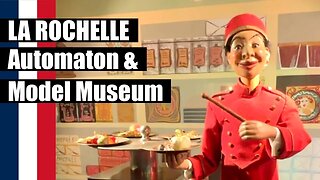A great train pack for younger model railway enthusiasts!
In this video we take a look at Hornby catalogue numbers R3489.
This is a "Railroad" series train pack, named "GWR Freight Train Pack" and features a Great Western Railway tank engine and 3 wagons in OO scale.
In this video I'll unbox this train pack and show you each of the models up close in detail. I then open the locomotive up to show you the motor and mechanism before we give it a run on the test track.
I'll also make a recommendation if you should consider buying this train pack or not.
Filmed in June 2023
Support me on Patreon! : https://patreon.com/LocomotionMotion
Share a coffee : https://www.buymeacoffee.com/Locomotion23
Check out my exclusive range of Trainspotting Books: https://www.amazon.co.uk/~/e/B0C8PLF7XS
Ebay model railway auctions (and more!): https://www.ebay.co.uk/usr/Locomotion_Motion
#modelrailways, #modeltrains #steamlocomotives #steam #steamtrains #lms #hornby #hornbyrailways #hornbymodelrailways #hornbytrains
The Great Western Railway (GWR) is a historic railway company in the United Kingdom. It was established in 1833 and played a significant role in the development of the railway network in Britain. The GWR initially operated primarily in western and southwestern England, connecting London with cities such as Bristol, Exeter, and Plymouth.
Isambard Kingdom Brunel, a prominent engineer of the time, was instrumental in the design and construction of the Great Western Railway. Brunel's vision was to create a railway with a broad gauge of 7 feet and a unique design that incorporated many impressive engineering feats. Notable among these was the Maidenhead Railway Bridge, which spanned the River Thames, and the Box Tunnel, which was the longest railway tunnel in Britain at the time.
The GWR became known for its luxurious passenger services, which included famous express trains such as the "Flying Dutchman" and the "Cornish Riviera Express." The company also introduced innovations such as dining cars and observation saloons, providing passengers with a comfortable and enjoyable travel experience.
In addition to passenger services, the GWR played a crucial role in freight transportation, particularly in the coal and iron industries. The railway connected various industrial regions, enabling the efficient movement of goods across the country.
During World War II, the GWR played a vital role in transporting troops, equipment, and supplies for the war effort. The railway network faced significant challenges during this time, including bombings and damage to infrastructure. However, it played a crucial role in supporting the war and was instrumental in the successful D-Day invasion in 1944.
In the years following the war, the British railway system underwent significant changes, including the nationalization of the industry in 1948. The GWR became part of the nationalized British Railways, and many changes were made to the network, including the standardization of track gauge to the narrower 4 feet 8.5 inches used in most of the country.
Despite these changes, the GWR name continued to be used, and in recent years, the brand has been revived by the current railway operator in the region. Today, Great Western Railway (GWR) operates train services in the southwestern and western parts of England, including routes to London Paddington, Bristol, Cardiff, and Exeter. The company strives to maintain the legacy of the historic Great Western Railway by providing modern and efficient train services while also celebrating its rich heritage.
-
 13:23
13:23
LOCOMOTION MOTION
4 months agoMuseum of Automatons & Scale Models (Musée des Modèles Réduits) - La Rochelle, France
20 -
 2:23:56
2:23:56
Spittin' Chiclets
4 hours agoSpittin’ Chiclets Episode 499: Playoff Madness
24.8K5 -
 1:30:35
1:30:35
Benny Johnson
4 hours agoHISTORY! Trump DOMINATES New Polls After +100,000 Patriot MAGA Rally | DNC in PANIC, Swap Biden? 🚨
56.6K99 -
1:35:28
jeffahern
4 hours agoMonday Madness with Jeff Ahern (9AM Pacific)
17.3K2 -
 1:10:34
1:10:34
Steven Crowder
4 hours agoMake Afroman Great Again: Afroman Sits Down For a ONE-OF-A-KIND Interview
103K387 -
 1:20:37
1:20:37
Graham Allen
6 hours agoBiden Camp PANICS After 100k+ Show Up For Surging Trump!
66.4K148 -
 2:43:11
2:43:11
Matt Kohrs
14 hours agoGameStop Is Squeezing, China on Tilt & The Week Ahead || The MK Show
48K8 -
 1:02:42
1:02:42
Rethinking the Dollar
4 hours agoThe Next Banking Event Will Be Off The Charts | Monday Morning Check-In: A Quick Glance IN The News
36K7 -
 1:37:00
1:37:00
The Podcast of the Lotus Eaters
10 hours agoThe Podcast of the Lotus Eaters #913
62.3K34 -
 6:37
6:37
Chris Jericho
1 day agoThe Unsolved Mystery & Murder of Rachel Morin
39.5K3